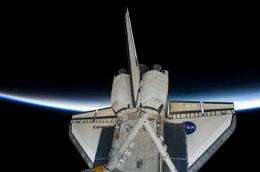In this April 13, 2010 file photo provided by NASA the space shuttle Discovery intersects the thin line of Earth's atmosphere photographed by an space shuttle crew member while Discovery remains docked with the International Space Station. NASA is already warning the space shuttle astronauts to expect rain delays as they get ready to come home. Discovery and its crew of seven are scheduled to land Monday morning, April 19, 2010 in Florida. (AP Photo/NASA, File)
(AP) -- NASA warned space shuttle Discovery's astronauts Sunday to expect rain delays as they wrapped up their two-week mission and got ready to come home.
Discovery and its crew of seven were scheduled to land Monday morning at NASA's Florida spaceport.
Shuttle commander Alan Poindexter said Sunday that he enjoys spending extra time in orbit and doesn't mind if Discovery can't make it back to Earth until Tuesday.
Mission Control promised to keep monitoring the weather in case the forecast improved. In the worst case, Discovery could always aim for the backup landing site in Southern California on Tuesday.
Poindexter and his crew are returning from the International Space Station after stockpiling it with supplies, science experiments and extra spare parts, including a tank full of ammonia coolant. It took three spacewalks to install the tank.
Providing Florida's weather cooperates, Discovery will crisscross much of the United States during re-entry, zooming in from the Pacific Northwest. For safety reasons, NASA typically prefers to bring a space shuttle home from the southwest, up over the South Pacific, Central America and the Gulf of Mexico.
It's a lesson NASA learned the hard way in 2003, when Columbia shattered over Texas during re-entry. All seven astronauts were killed, but remarkably, no one was hurt on the ground by the wreckage.
Since then, only one other shuttle mission has ended with a continental flyover, back in 2007.
Before Discovery's April 5 liftoff, NASA altered the flight path to maximize the astronauts' work time in orbit without wearing them down.
The rare U.S. flyover - weather permitting - was going to provide a streaking light show for those beneath the flight path. For Monday's first landing opportunity at 8:48 a.m., Discovery would zoom over British Columbia and Alberta, swing down over Montana and the Dakotas, and pass over Sioux City, Iowa, and the middle of Missouri. Then it would come down over the eastern border of Arkansas and Tennessee, then over northeastern Mississippi and Alabama, southwestern Georgia and almost directly over Jacksonville.
The second opportunity, 1 1/2 hours later, would have the shuttle crossing over Washington state and passing over more of the heartland.
Of course, a landing in California would scratch all this.
Only three shuttle flights remain. Pilot James Dutton Jr. said that was on his mind as he flew Discovery away from the International Space Station on Saturday.
"Definitely as we were backing away from the space station yesterday, there were a lot of oohs and aahs on the flight deck," Dutton told The Associated Press in an interview. "It was just absolutely beautiful to see that manmade creation up there, floating above the Earth."
He added: "The shuttle has made a huge contribution to space exploration."
The astronauts said they've been keeping up with news about NASA's change of course. President Barack Obama outlined his exploration plans during a visit Thursday to Kennedy Space Center, promising astronauts would head to an asteroid by 2025 and Mars by 2035.
"It's cool to think that we're back in the exploration business," astronaut Dorothy Metcalf-Lindenburger told the AP.
Metcalf-Lindenburger, 34, a former high school teacher, said she's from a generation that did not get to witness the Apollo moon landings. So she was excited about the previous administration's effort to return astronauts to the lunar surface.
"But an asteroid is quite a challenge" and could save the planet from the kind of destruction and extinction that occurred in the past, she noted.
"Wherever we go out in our solar system, from a teaching standpoint, I really hope that students are engaged in learning math and science, and taking as much advantage of the technology we have," she said. "We should always try to be a leader in this."
More information:
NASA: http://www.nasa.gov/mission-pages/shuttle/main/index.html
NASA: http://spaceflight1.nasa.gov/realdata/sightings/
©2010 The Associated Press. All rights reserved. This material may not be published, broadcast, rewritten or redistributed.






















